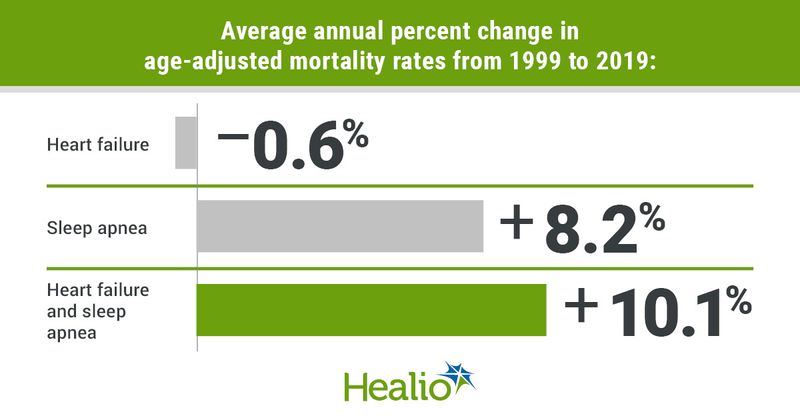Mortality burden related to heart failure with sleep apnea increasing in US
HONOLULU — Heart failure and sleep apnea-related mortality significantly increased over the last 2 decades, with greater risks among the elderly, men and Black individuals, according to data presented at the CHEST Annual Meeting.
This finding may be related to the increasing prevalence of sleep apnea as a comorbidity among individuals with heart failure in the U.S., according to the researchers.


“We found it interesting that there has been a persistent increase in mortality related to both sleep apnea and the combination of heart failure and sleep apnea,” Aleezay Asghar, MD, internal medicine chief resident at UMass Chan Medical School-Baystate, told Healio. “This is particularly intriguing given that heart failure mortality has remained steady or even declined during this period. This may, in part, be due to the rising prevalence of sleep apnea, increased awareness among patients and clinicians, and improved diagnostic modalities leading to increased reporting of sleep apnea on death certificates.”
About 50% of patients with heart failure have sleep apnea which, in turn, increases their risk for mortality, the researchers noted.
“Recent estimates suggest that the prevalence of sleep apnea has also been steadily rising which could potentially affect the mortality risk in heart failure,” Asghar said. “To our knowledge, contemporary national estimates of heart failure and sleep apnea-related mortality have not been studied, so we decided to evaluate the temporal trends of mortality related to both these conditions in the U.S.”
To do so, researchers used 1999 to 2019 data on deaths related to heart failure and sleep apnea among adults aged 25 years or older in the CDC Wide-ranging ONline Data for Epidemiologic Research, or CDC WONDER, database. They used these and sociodemographic data to calculate age-adjusted mortality rates (AAMR) per 100,000 population.
Overall, researchers observed AAMRs per 100,000 deaths of 143.9 for heart failure, 4.5 for sleep apnea and 1.2 for both heart failure and sleep apnea.
Despite finding a decrease in the AAMR for heart failure over the study period, with an average annual percent change (AAPC) of –0.6% (95% CI, –1.1% to –0.1%), researchers observed a significant increase in the AAMRs for sleep apnea-related mortality, with an AAPC of 8.2% (95% CI, 7.7%-8.7%), and combined heart failure and sleep apnea-related mortality, with an AAPC of 10.1% (95% CI, 9.1%-11%).
This trend in AAPC for heart failure and sleep apnea-related mortality appeared higher for men (10.1%; 95% CI, 9.4%-10.8%) than women (9.9%; 95% CI, 8.8%-11.1%), with a consistently higher AAMR seen among men (1.65 per 100,000 vs. 0.84 per 100,000).
Also, Black or African American individuals appeared at greater risk for heart failure and sleep apnea-related mortality, with an AAMR of 1.69 per 100,000, followed by white (1.2 per 100,000) and Hispanic or Latino (0.67 per 100,000) individuals. Researchers also noted that white individuals had the greatest increase in AAMR over the study period, with an AAPC of 11.2%, followed by Hispanic individuals with a 7.6% AAPC and Black individuals at 6.4%.
“There is variable evidence on whether men with sleep apnea are at higher risk of developing heart failure vs. women,” Asghar said. “However, we found consistently higher mortality rates among men with both these conditions, as well as among African American individuals. Our results corroborate findings from prior studies that have also shown higher mortality rates individually associated with sleep apnea and heart failure in African American individuals. Our study reinforces the need for early recognition and management of sleep apnea in patients with heart failure, especially in high-risk populations, to potentially improve outcomes.”
Also, individuals aged older than 75 years had the highest AAMR, at 5.51 per 100,000, compared with AAMRs of 2.18 per 100,000 among individuals aged 55 to 74 years and 0.26 per 100,000 among those aged 25 to 54 years. Further, the oldest group also had the greatest increase over the study period, with an AAPC of 11.1% (95% CI, 10.4%-11.8%), compared with 9.2% for those aged 55 to 74 years and 4.1% for those aged 25 to 54 years.
Next, researchers plan to assess how comorbidities affect these trends, as well as whether there are any differences with obstructive vs. central sleep apnea, Asghar said.
“The aim is to further identify high-risk patients who may benefit from early diagnosis and treatment of sleep apnea,” she said.

